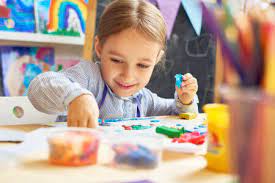
What Activities For Children Can Promote Imagination and Creativity
What Activities For Children Can Promote Imagination and Creativity is crucial for their cognitive and emotional development. Encouraging kids to explore their creative side not only enhances their problem-solving skills but also fosters a lifelong love for learning. Here are some activities that can stimulate imagination and creativity in children:
Artistic Expression:
-
- Drawing and Painting: Provide children with a variety of art supplies, such as crayons, markers, colored pencils, and watercolors. Encourage them to create their own artwork without strict guidelines, allowing their imagination to flow freely.
- Collage Making: Give kids old magazines, newspapers, and glue to make collages. This activity allows them to experiment with different materials and themes.
Storytelling and Writing:
-
- Storytime: Reading books together can inspire children to create their own stories. After reading, ask them to come up with alternative endings or create their versions of the story.
- Creative Writing: For older children, provide them with journals or notebooks to write their stories, poems, or journals. Encourage them to let their ideas flow on paper.
Role-Playing and Pretend Play:
-
- Dress-up: Keep a collection of costumes and props to facilitate imaginative play. Children can pretend to be different characters, fostering creativity as they invent stories and scenarios.
- Pretend Kitchen or Store: Set up a pretend kitchen or store with play food and cash registers. This allows kids to mimic real-world scenarios and create their own scenarios.
Building and Construction:
-
- LEGO and Building Blocks: These toys encourage children to build structures and invent their designs. It promotes problem-solving and spatial awareness.
- Cardboard Boxes: Don’t underestimate the power of cardboard boxes. They can be transformed into castles, spaceships, or any other creative structure with a little imagination.
Nature Exploration:
-
- Outdoor Adventures: Take children on nature walks or hikes. Encourage them to observe and collect items like leaves, rocks, or sticks. Later, they can use these natural materials in art or craft projects.
- Gardening: Involve children in gardening activities. Planting and nurturing their garden fosters a sense of responsibility and creativity.
Music and Dance:
-
- Musical Instruments: Introduce children to musical instruments like a keyboard, guitar, or drums. Let them experiment with sounds and rhythms.
- Dance and Movement: Encourage dancing to different styles of music. Dance helps children express themselves creatively through movement.
Science Experiments:
-
- Simple Science: Conduct simple science experiments at home. For example, make a volcano with baking soda and vinegar or grow crystals. These activities spark curiosity and imagination.
- STEM Toys: Invest in STEM (Science, Technology, Engineering, and Mathematics) toys and kits that promote hands-on learning and problem-solving.
Imagination Prompts:
-
- Imagination Games: Play games like “What If?” where children imagine various scenarios. Ask questions like, “What if you could travel back in time?” or “What if you could visit outer space?”
- Story Starters: Provide a sentence or a few words as story starters, and encourage children to continue the story in their own creative way.
Cooking and Baking:
-
- Simple Recipes: Involve children in the kitchen. Baking cookies or making simple recipes allows them to experiment with ingredients and flavors, fostering creativity in a delicious way.
Open-Ended Playtime:
-
- Allow unstructured playtime where children can explore and create without any specific rules or guidelines. This gives them the freedom to let their imagination run wild.
Remember that the key to promoting imagination and creativity in children is to provide a supportive and encouraging environment where they feel free to express themselves and explore their interests without judgment. By incorporating these activities into their daily lives, parents and caregivers can nurture the creative spirit in children and help them develop important life skills


